|
Here is a selection of the gallery's most recent acquisitions
including paintings from five members of the National Academy.
Just scroll down to see each painting.
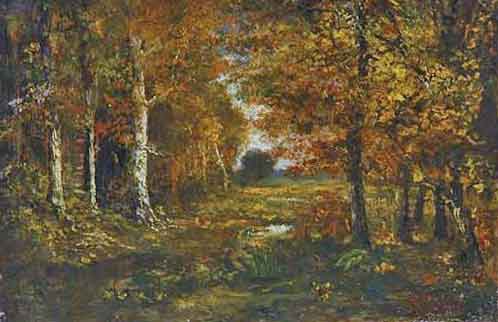
Narcisse Virgile Diaz de la Peña (French, 1808-1876)
Foret de Fontainbleau
Signed "Diaz" l.r.
Oil on board, 8 x 12 in.
antique Barbizon frame
SOLD
Narcisse Diaz, a French landscape and figure painter and founding member of the avant-garde Barbizon school, was born in Bordeaux of Spanish parents. His parents were refugees from Joseph Bonaparte's Spain. By the age of ten, he was a penniless orphan in the care of a priest at Bellevue near Paris.(1). The young Narcisse, who had lost one of his legs to blood poisoning, was apprenticed as a pottery decorator in Paris at the age of 15, which may account for his later predilection for bright colors and his rather free draftsmanship. His handicap, and its impact on his mobility, were to be determinant in the course of his future career. As was a common practice, Narcisse learned to paint at the Louvre, where he was drawn to the works of the colorists. His early inspiration came most notably from Correggio, whose Antiope he repeated and interpreted in his own Nymphe Endormie (also in The Louvre).
Narcisse first exhibited at the Salon between 1831 and 1837. From 1837 to 1844, he was a founding member of the Barbizon school, named for a small village at the edge of the Forest of Fontainebleau. It was during this period that his future greatness became manifest. During the ensuing years, he was awarded three Salon gold medals for painting, and, in 1851, was named a Knight of the Legion of Honor. At the 1846 Salon, Narcisse's entries garnered the praise of Théophile Gautier: "There is in painting, as in music, a purely sensual side, in which the eye delights in the color - as the ear delights in the note - for its own value and sonority ... A major green or a minor yellow are delicacies which charm the eye. One can but admire the love of hues for their own sake which Diaz manifests, and on which his reputation rests." With the Salon of 1848, the Barbizon School of painters became a definite, recognized entity, dominating French landscape painting through the late 1860's.
Well into the 20th century, until Impressionism took over, the art of Diaz, Corot, Daubigny, Théodore Rousseau and Millet constituted the natural vision of the world, the most sought-after art in Western culture. Collections of Diaz de la Peña's paintings are in The Louvre, The Reims Museum, and The Metropolitan Museum of Art in New York (which has A Clearing in the Forest of Fontainebleau), the Museum of Fine Arts, Boston, and his Valley Marsh at the Cincinnati Art Museum. There is a significant collection in Paris (32 at the Louvre), in London (four at the National Gallery, four at the Victoria and Albert Museum, and three in the Wallace Collection), and at The Hague (eight at the Mesdag Museum).
Biography from Westbrook Galleries:

Jose Weiss (1859-1919)
Barbizon Study (oil on Board, 22" x 26")
Gilded Antique Wood Frame, 27" x 31"
Price available upon request
José Weiss (1859-1919) was a talented Paris-born landscape painter who settled in England in 1893. Exhibited at the RA, RBA and the Paris Salon. Lived at Houghton, near Arundel, from 1897 and painted the Sussex landscape. His landscapes reflected prevailing trends in Europe, being chiefly influenced by the Barbizon school and Impressionism. He is known for his detailed paintings of landscapes, often along rivers, where he could display his exceptional skill in capturing the play of light and shadow.
Weiss was a keen student of birds since childhood, and for years had speculated on their remarkable ability to soar on seemingly motionless wings. Weiss devoted much of his time to studies of the theory of flight. Between 1902 and 1907 he designed, constructed, and flew hundreds of models, gradually developing his own theory of inherent stability based on bird forms. Weiss's theories on wing design for inherent stability were recognized and respected in aviation circles of the day. In describing Jose Weiss's contributions to aeronautical lore, one aviation historian compared his universal genius to that of Leonardo da Vinci.
'In this type the mind and the eye of the artist are conjoined with the scientific mind. They think with the eye and the soul as well as with the brain. Such men have the joy of great vision, of peering into the mysteries; but often others, inspired by them, accomplish the practical work'

ALBERT BABB INSLEY (1842-1937)
"SURF AT PORT CLYDE, MAINE", 1915.
Oil on canvas 14" x 19" in a fine carved wood gilt frame 22” x 27”
PROVENANCE: Acquired from the grandson of the artist.
$2800
Landscape and marine painter Albert Babb Insley was born in 1842, growing up in Jersey City, New Jersey. He was active early in the arts. At age fourteen in 1856, he received his first major painting commission of the Llewellyn Park Estate of D.C. Otis; and the same year he left school to become an apprentice photographer under his father, Henry Earle Insley, who was one of the earliest pioneer photographers in America. In 1860, at age 18, Insley made his first of many painting trips to the Green and White Mountains of Vermont and New Hampshire and to the Shawangunk Mountains of New York.
When only twenty-five, Insley began exhibiting on a regular basis at the National Academy of Design in New York City, having exhibited 36 times from 1862 to 1898. He continued his artistic studies, even as an exhibiting artist, with the well-known Jasper Cropsey in 1864 and 1865. By the early 1860s, he was an art instructor with Henry L. Hillyer at New York University, Waverly Place, New York City. He was also a long-time exhibitor from 1869 to 1891 at the Brooklyn Art Association.
In New York City, he lived and worked at the Tenth Street Studio Building for 48 years. He also took regular painting trips north of the city and across the Hudson River in New Jersey, as well as in the New England states. In the early 1880s, Insley's work reflected the influence of the Barbizon School of France. Insley took an art class on glazing techniques with George Inness Sr. who influenced him to become looser and more expressive. During the summers of 1864 and 1865, he studied landscape painting with Jasper Francis Cropsey at his home on Greenwood Lake, which caused him to lighten his palette.
The long-lived artist died in Nyack, New York in 1937 at age 95. His memberships included the Boston Arts Club, Brooklyn Art Association, Nanuet Painters and Sculptors Guild, National Academy of Design, Pennsylvania Academy of the Fine Arts, and the Salmagundi Club. His collections include the Archives of American Art, Washington, D.C.; Cragsmoor Free Library, New York; Delaware Art Museum, Wilmington; Harding Museum, Chicago; Jersey City Museum, New Jersey; Preservation Society, Newport, Rhode Island; and the Rockland Historical Society, New York.
Sources:
Michael David Zellman, "300 Years of American Art"
Peter Falk, "Who Was Who in American Art"
"The Delicate Palette of Albert Insley" Antiques and the Arts Weekly, June 22, 1984
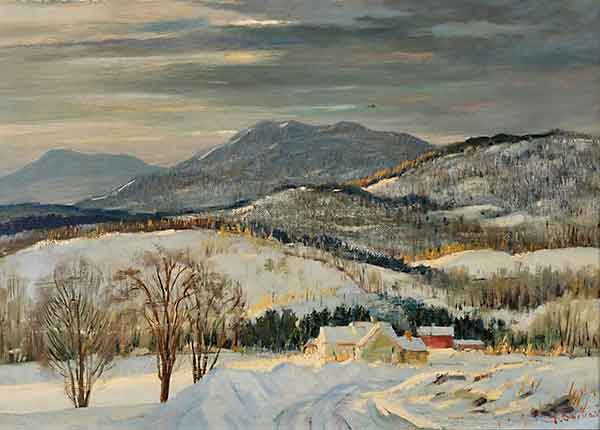
Frank Gervasi, NA (1895-1986)
Winter Morning, Vermont
Oil on Canvas 12x16
SOLD
Gervasi was born in Palermo, Sicily, and immigrated to New York at the age of 13 in 1908. His art career was interrupted by World War I, in which he lost his right arm at the Battle of Somme in France. He overcame this adversity and inspired other wounded veterans when he learned to paint with his left arm. He studied at the Art Students League in New York with important artists such as Robert Henri and George Luks, and was elected a member of the National Academy of Design (hence the initials N.A. after his signature) in 1956. In 1960 he relocated to Marfa, Texas, to complete a mural commission. He remained in Marfa, painting landscapes in Texas and New Mexico, until his death at the age of 91. His paintings are in museum collections in Minnesota, Colorado, and Texas, and he is listed as a a well-sold artist in auction directories including ArtPrice and AskArt.
The artist lived in Brooklyn Heights, Brooklyn, New York for a number of years and later in Tudor City in Manhattan. He painted in oil the mountains of the Catskills, the Adirondaks, the skyscraper canyons of the city, still life and watercolor pieces. In l955 the "New York Times" featured a story and photograph of his painting, "Fire Escape."
Gervasi was a member of National Academy of Design, Allied Artists of America and American Watercolor Society. Salamagundi Club and Audubon Artists.
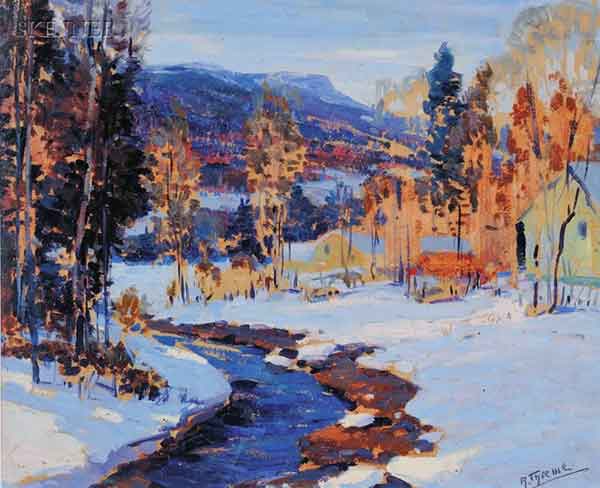
Anthony Thieme, NA (1888-1954)
Landscape in Winter
Oil on Board 13.5x16.5
Framed under glass with mat 21x24
price available upon request
Anthony Thieme was born on February 20, 1888 in Rotterdam, Holland. He studied at the Royal Academy of Fine Arts in The Hague, Holland, under George Hacker; Garlobini, Guardaciona; and Mancini in Italy. He also studied in Germany. In the 1920's he emigrated to the United States, initially residing in New York City where he painted Broadway backdrops, and eventually setting up studios in Rockport, Massachusetts and St. Augustine, Florida, seasonally moving from one to the other.
Known as a genre painter he did landscapes including farms, and Paris scenes; his best known works are of boats, fishermen, and harbors, reflecting his Northern and Southern studios in coastal towns. In Rockport, he established the Thieme School of Art where he was Director.
Thieme was a strong proponent of the visual arts and held memberships in many associations: American Water Color Society; Art Alliance of America; Salmagundi Club; Connecticut Academy of Fine Arts; Boston Art Club; Providence Water Color Club; Boston Society of Artists; North Shore Art Association; Springfield Art League; Rockport Art Association; New York Water Color Club; American Artists Professional League; Gloucester Society of Artists; Art Alliance of Philadelphia; Philadelphia Painters Club; and the National Arts Club.
As a function of these many memberships, he was an active exhibitor: National Academy of Design 1930-1934; Art Institute of Chicago 1930; Pennsylvania Academy of Fine Arts 1929-1931; Corcoran Gallery of Art 1932; Los Angeles Museum of Art 1930, 1931 (prize); Albright Art Gallery 1932; Detroit Institute of Art 1931; Salmagundi Club 1929 and 1931 (prizes); Springfield, Utah 1928 and 1931 (prizes); Gloucester Art Association 1928 (prize); Springfield Art League 1927 and 1928 (prizes); North Shore Art Association 1930 (prize); Connecticut Academy of Fine Arts 1930 (prize); Jordon Marsh Exhibition (Boston) 1944 (medal); New York Water Color Club 1930 (prize); Boston Tercentenary Exhibition 1930; Ogunquit Art Center 1930; New Haven Painters and Clay Club 1931 (prize); Washington Water Color Club 1931(prize); Los Angeles Museum of Art; Buck Hill Falls Art Association (Pennsylvania) 1938 (prize); he also exhibited in Belgium, France and Holland.
Anthony Thieme's work is held in high regard by collectors and Museums alike, and he is represented in many major collections: Boston Museum of Fine Art; Pittsfield Museum of Art (Massachusetts); Albany Institute of History and Art; Dayton Art Institute; City of New Haven Collection; College of Springfield (Utah); University of Iowa; Museum of Modern Art; Los Angeles Museum of History, Science & Art; Beach College, Storrs, Connecticut; Montclair Art Museum (New Jersey).
In literature, he is internationally recognized appearing in Benezit; Davenport; Fielding; Mallett; Thieme-Becker; the Witt Library Computer Index; and many "Who's Who."
The Rockport Art Association held a retrospective exhibition of his works and the accompanying text details his life and works: Judith A Curtis, "Anthony Thieme 1888-1954," Rockport Art Association, 1999. (80 pages)
Source: Edwin J. Andres Fine Art

William Lester Stevens (American, 1888-1969)
Gaspe Peninsula, Perce Rock
Signed "W. LESTER STEVENS N.A." l.r.
Oil on Canvas, 24 x 28 in.
Available
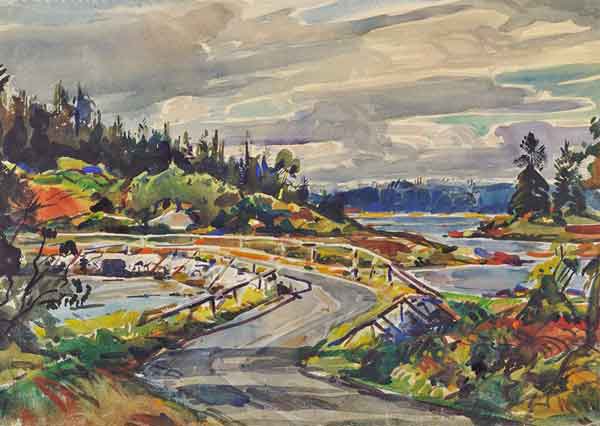
William Lester Stevens, NA (1888-1969)
Deer Isle, Maine
Signed "W. LESTER STEVENS N.A." l.r.
Watercolor 20 x 27 in.
Matted and Framed, Condition: excellent
$2400
Born in Rockport, Massachusetts, Stevens spent four years at Boston's Museum of Fine Arts School, where he studied under Edmund Tarbell, among others. Primarily an oil painter, he also used watercolor and acrylics. He is best known for his post-impressionistic landscapes. Throughout the course of his long career, Stevens taught, first in Rockport, then at Boston University (1925-1926) and Princeton (1927-1929), and during the Depression at Grand Manan.
He was a National Academician and a member of the American Watercolor Society; a founding member of the Rockport Art Association; Springfield, MA Art League; Guild of Boston Artists; Gallery on Moors; New Haven Paint and Clay Club, CT; Gloucester Society of Art; North Shore Art Association; Boston Watercolor Club and the New York Watercolor Club. He won art awards at the Corcoran Gallery, Washington, DC; American Watercolor Society; New Haven Paint and Clay Club; Springfield Art League; Salons of America; Washington Watercolor Club; North Shore AA; Rockport AA and more. He painted USPO murals in Dedham and Rockport, MA, the Boston City Hall, the Louisville, KY Art Museum and several schools in Boston. References: Movalli, Charles, American Artist (April 1986); Who’s Who in American Art (1947); Who Was Who in American Art (vol. 3, p. 3171-72).
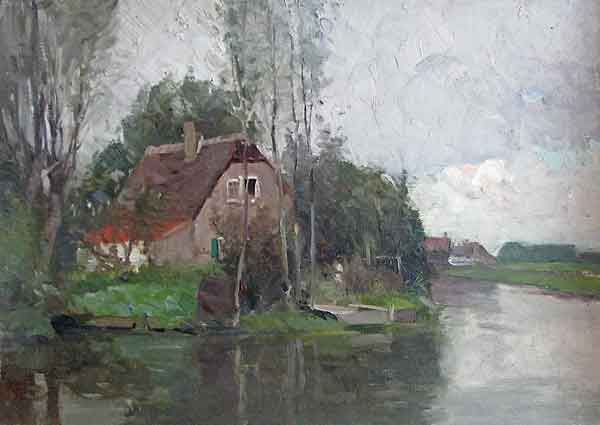
Charles H. Woodbury (1864-1940)
Lakeside Cottage
Oil on Canvas: 10 X 14
$3500
Born in Lynn, Massachusetts, an industrial city about ten miles north of Boston, Charles Woodbury remains among the most influential artists to work in Ogunquit, Maine and in Boston. He taught more than 4,000 students including ones at Wellesley College, had more than 100 solo exhibitions, and wrote three widely read art education books. He remains a strong influence on art education.
Woodbury was from a comfortable, well-established family. He sold his first oil painting when he was 15 and at age 17 in 1884, was the youngest person ever elected to the Boston Art Club. He graduated from the Massachusetts Institute of Technology, and credited Ross Turner, his watercolor instructor, as launching his painting career.
As a young resident painter of Lynn, he was a leader among his artist colleagues in the formal application of paint in beach and marsh scenes, a unique subject for that time. Immediately after graduating from MIT, he set up a studio at 22 School Street in Boston near Charles Green, his close friend and painting colleague. They determined to make a living only from their painting, and they succeeded. His formal art training began in 1890 when he, a newly married man, enrolled in the Academie Julian in Paris and stayed for a year. Returning to the Boston area, he became a prominent plein-air painter and living until 1940 embraced Impressionism.
He was a member of the Salmagundi Club (1899); an Associate (1906) and an Academician (1907) at the National Academy of Design; Ogunquit Art Association; Society of Water Color Painters; New York Water Color Club; Guild of Boston Artists; Boston Society of Watercolor Painters.
He won awards at the Lynn Art Exhibition for Amateurs (1880); Boston Art Club (1884, 1895); Atlanta Exposition (gold, 1895); Nashville, Tennessee Centennial (1897), Mechanics’ Fair, Boston; Paris Exposition (1900); Pan-American Exposition, Buffalo (1901); Worcester Art Museum (1903,1907); St. Louis Exposition (1904); Carnegie Institute (1905); Buenos Aires Exposition (1910); American Water Color Society (1911); W.A. Clark Prize and Corcoran Medal (1914); Pan-Pacific Exposition, San Francisco (gold, 1915); Penn. Academy of F.A. (gold, 1924); Brooklyn (1931); Palmer Marine Prize and Ranger Fund Award, National Academy (1932); Noyes Prize, Society of American Artists (1933).
He is represented at the Gardner Museum; Corcoran Gallery of Art; Art Institute of Chicago; Herron Art Institute; Boston Museum of Fine Arts; St. Louis Art Museum; Boston Public Library; Berkshire Atheneum; Detroit Art Institute; Metropolitan Museum of Art; Joslyn Art Museum; Worcester Art Museum; R.I. School of Design; Telfair Academy, Savannah; Colby College; Wellesley Colllege and in 100’s of other museums and institutions.
Woodbury was given over 60 one-man exhibitions, the first being at the J. Eastman Chase Gallery, Boston (1887) and the last at the Winchester Public Library, MA (1939). 18 Memorial Shows were given (1940-41). In 1945 the Museum of Fine Arts, Boston held a Retrospective Exhibition. In 1968, Adelson Galleries, Inc. (then of Boston) and in 1978 Vose Galleries of Boston gave Retrospectives. In 1988 M.I.T. gave a monumental Woodbury exhibition titled Earth, Sea and Sky that traveled to museums through 1993.
Woodbury taught art at the Worcester Art Association (1895); Wellesley College (1899-1906; 1913-1914); Dartmouth College; Pine Hill School (1907-1910); Ogunquit summer art school (1898-1939); Director, Woodbury School, Boston; Associate Professor, School of the Chicago Art Institute.
Author: The Art of Seeing (1925) and Painting and the Personal Equation (1922).
Sources include:
P.J. Pierce
American Art Review, August 1998
Peter Falk (Editor), Who Was Who in American Art
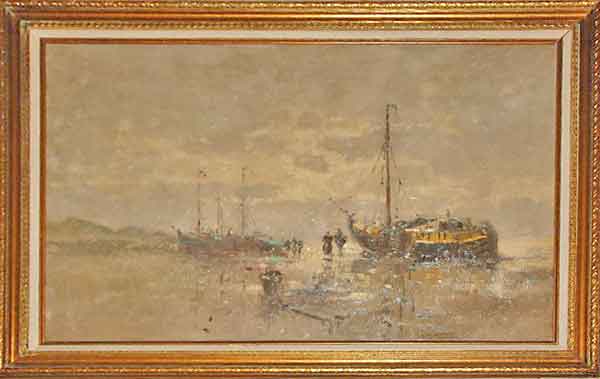
William Norton (1843-1916)
Disemarking at Low Tide
Oil on Canvas 24 x 36
$6500 framed
Born in Boston in 1843, William Norton became a noted marine painter, stirred by his youth when he sailed on family-owned ships. He studied at the Lowell Institute in Boston, and with George Inness, and then established a studio in Boston.
In the early 1870s, he went to Paris and became a student with Chevreuse and A. Vollon, and then he settled in London where he exhibited throughout the last quarter of the 19th century. His reputation there was based on his scenes of the Thames River, and ocean and coastal views.
In 1901, he and his wife returned to the United States and settled in New York City. He also painted at Monhegan Island, Maine, where a treacherous ledge on the southern side of the island is named "Norton's Ledge" for him.
He was a member of the Boston Art Club with whom he exhibited from 1873 to 1909. He also exhibited with the Pennsylvania Academy, the Royal Academy in London, the Paris Salon, the 1893 Chicago Exposition, and the Art Institute of Chicago.
Source: Who Was Who in American Art by Peter Falk
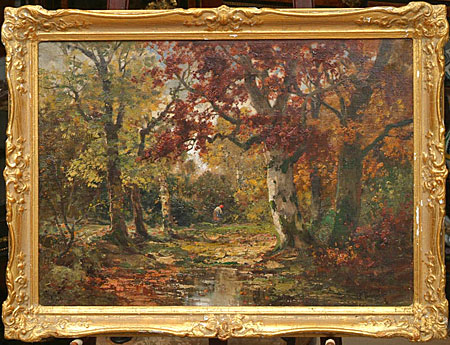
Foret d'Autumne
P. Dumont
AUTUMN FOREST ca 1930
oil on canvas 19 x 25
Period Gold Frame; 24 x 30
signed lower right "P. Dumont"
Condition: excellent with no restoration
Available
This post-Barbizon era painting is reminiscent of the extraordinary forest interiors painted on site in the forest of Fontainebleau by the first generation of Barbizon painters, particularly Rousseau and his pupil Diaz de la Pena. Compare it with the Barizon Forest masterpiece by Diaz de la Pena above
Initially influenced by French Barbizon painting by way of American exponents George Inness (1825-1894), William Morris Hunt (1824-1879), American painters in the Tonalist school tended to use a neutral palette carefully modulated to produce a dominant tone. Preferred subjects were scenes of dawn or dusk, rising mist and moonlight in which the enveloping atmosphere is evocative of poetic and meditative states.
(Robert) Bruce Crane, NA (1857-1937)
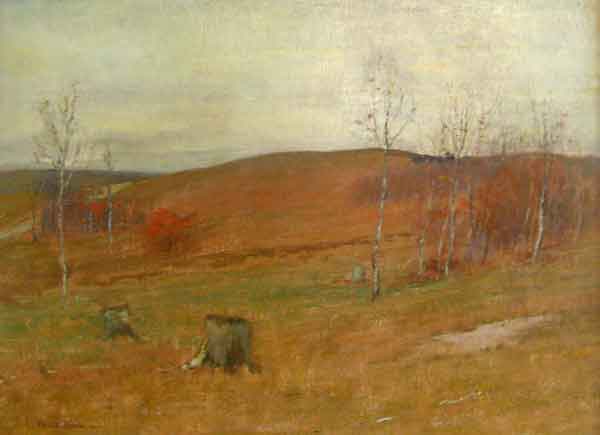
FALL CONNECTICUT LANDSCAPE
Signed lower left "Bruce Crane. N.A."
SIZE: 22" x 30"
Fine deep carved frame: 31” x 39”
(Robert) Bruce Crane, NA (1857-1937)
Robert Bruce Crane was born in New York City on October 17, 1857. The son of Solomon Bruce Crane and Leah Gillespie, he was educated in New York's public schools and was exposed to the city's galleries and museums by his father, himself an amateur painter. By the age of seventeen, Crane had moved to Elizabeth, New Jersey, where he was employed as a draftsman by an architect and builder. He soon decided to devote his career to painting, and about 1876 or 1877 sought the guidance of the landscape painter Alexander H. Wyant, with whom he subsequently shared a close friendship until Wyant's death in 1892.
Between 1878 and 1882, Crane attended the Art Students League in New York and traveled to Europe for further study. In the United States during this period, he painted in New Jersey; East Hampton, Long Island; and the Adirondacks. He wrote to his father from the Adirondacks that among the influential painters working nearby at the time were Eastman Johnson, George and James Smillie, and Samuel Coleman, and he described the dramatic terrain: "Went to the famous Rainbow Falls which several artists have tried to paint . . . Wyant and Hart among them . . . over the top comes tumbling the water which strikes every few feet throwing a spray which catches the sun giving a most charming as well as wonderful appearance."
Crane spent time in East Hampton, on the eastern end of Long Island, during the summer of 1880 or 1881 and possibly during other summers. In these early works, Crane painstakingly reproduced the pastures, hayfields, and barnyards of rural East Hampton. A critic later remarked that "Troubled or placid skies, the bright luminous atmosphere of a summer's day, or the gray tones of autumn were given in these pictures, not only with truth to nature and a certain poetic sentiment, but with a brilliant sparkling quality of effect.
Source:
Clark, Charles Teaze; "Bruce Crane, Tonalist Painter", Antiques Magazine, November, 1982.
|
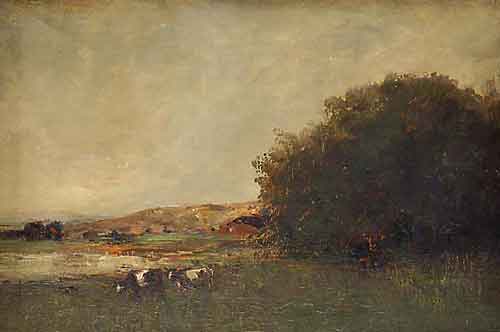
CHARLES EDWIN LEWIS GREEN (1844-1915)
RED ROCK, LYNN, MASSACHUSETTS. 1881
Signed lower right "C Green 81"
Oil on canvas, 11-3/4" x 15-1/2"
Available
A native of Lynn, Massachusetts, Charles Green became an artist committed to painting American subject matter, especially the marine and landscape scenes of his native area. He often signed his paintings C.E.L. and was part of the seven "Lynn Beach Painters" that included his close friend, Charles Woodbury.
From the 1880s through 1910, he was a regular exhibitor at the Boston Art Club and also took lessons there. He was a plein-air painter, meaning he completed his landscape and marine scenes outdoors with minimal over painting of colors.
In 1885, he moved to Boston, and he and Charles Woodbury had adjoining studios on Green Street and committed themselves to making their living exclusively with their fine art. They succeeded, and for several years, they were linked together as being non-European trained, stay-at-home artists with very similar impressionist styles and American subject matter. They prided themselves on avoiding European influence, but in the 1890s, their styles became increasingly impressionist from seeing European work in Boston exhibitions.
Green had his first one-man show in 1886 at the J Eastman Chase Gallery, one of Boston's most prestigious exhibition venues at that time. In 1906, Green moved from Boston to his hometown of Lynn where in 1909, he became one of the founders of the Lynn Art Club. He died on January 18, 1915, having been a major influence on succeeding generations of painters inspired to paint local marine scenes of the Boston area.
Source: Michael David Zellman, "300 Years of American Art"

Harrison Bird Brown (1831-1915)
Maine Coast in Autumn
Oil on Canvas 13x23
$5500 With new ornate Frame
Harrison Bird Brown was born in 1831 in Portland, Maine, and is best known for his White Mountain landscapes and marine paintings of Maine's Casco Bay. By 1860, Brown was being praised as a leading American marine painter.
Landscape painting was popular in the mid 19th century, thanks in part to the influence of Charles Codman (1800-1842), whose paintings were collected for their very romantic sentiments. It is possible that Brown saw examples of Codman's poetic paintings, and was influenced by his works. Brown was one of the early artists to paint the coastline of Maine's Monhegan Island, where he depicted the headlands as awesome, mystical forces. Humanity versus nature, and the human relationship to nature, themes prevalent in mid and late-19th century literature and philosophy, figured frequently in his seascapes.
He often painted in the White Mountains, and his name can be found in the guest registers of many places artists frequented in those mountains. The coast of Maine was also a favorite painting venue of Brown's for over thirty years. He depicted the wholesome outdoor environment of the state, with special fondness for the Casco Bay area and Grand Manan, an island off the New Brunswick, Canada coast. Brown also produced two widely distributed illustrations of Crawford Notch for the Maine Central Railroad in 1890.
Harrison Bird Brown exhibited at the National Academy of Design in New York from 1858 to 1860, and at the Boston Athenaeum and Philadelphia Centennial Exposition in 1876. By 1892 he had become the best known native Maine painter of his time, and gained fame for himself and the state with a large canvas in the Maine pavilion of the 1893 World's Colombian Exposition in Chicago. In 1892 he was elected president of the Portland Society of Art.
That same year, however, he moved to England to be with his only surviving child, a daughter, and spent the last twenty-three years of his life there. Most of his paintings were completed in New England before he moved to London, but he continued to paint until his death in 1915. Harrison Bird Brown's works can be seen at the Peabody Museum in Salem, Massachusetts and at the Portland Museum of Art.

FRANKLIN BENJAMIN DEHAVEN, N.A. 1856-1934
19th Century watercolor, 9 x 18 in.
Antique Gilt Cove molding frame, 20 x28 in
Signed lower left, F. Dehaven.
Available
Franklin B. DeHaven was born in Bluffton, Indiana on December 26,1856. DeHaven moved to New York City in 1886 and became a student of George Henry Smillie who was concentrating upon rural New England and Atlantic shoreline scenes, especially around East Hampton, Long Island. It is not surprising to find latter-day Hudson River School influences mixed with Barbizon or Tonalist sensibilites in much of De Haven's work. Most of his works were done in the New England area.
His paintings are characterized by variety, excellent draftsmanship, and a thorough understanding of nature. Dramatic skies are almost always a major element. Evening at Monomet is DeHaven's most famous and probably his best painting. Exhibited at the Prize Fund Exhibition held in the American Art Galleries of New York City in 1889, it is a beautiful evocation of a sunset on the Maine Coast.
DeHaven was a member of the National Academy of Design, ANA 1902, NA 1920, the Salmagundi Club 1899 (president 1926-1927), the National Arts Club, and the Allied Artists of America. He exhibited at the National Academy of Design 1886-1934, the Brooklyn Art Association 1886, the Pennsylvania Academy of Fine Arts 1898-1906, 1921, the Boston Art Club 1892-1906, the Art Institute of Chicago 1889, 1904, 1914, the Salmagundi Club, 1900 (prize), 1901 (prize), 1925 (prize), the Pan-American Exposition , Buffalo, New York 1901 (prize), the Charleston Exposition 1903 (silver medal), the St. Louis Exposition 1904 (silver medal), the Society of Independent Artists (1917, the National Arts Club 1921 (prize), and the Allied Artists of America 1930 (gold medal).
A tonalist painter, he exhibited at the prestigious National Academy of Design for over 50 years. He was familiarly known as "Pop" to members of the even more prestigious Salmagundi Club. His work is represented at the National Gallery of Art, Smithsonian, Washington DC, the Brooklyn Museum of Art, New York, the Butler Institute of American Art, Youngstown, Ohio, the Colby College Museum of Art, Waterville, Maine, the Columbus Museum of Art, Columbus, Ohio, the Newark Museum, Newark, New Jersey, and the Wells County Historical Museum - DeHaven Gallery, Bluffton, Indiana.
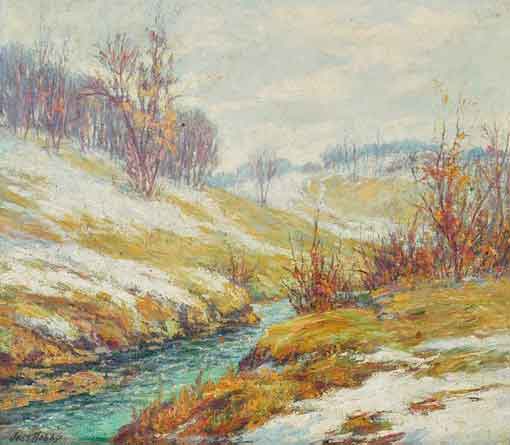
Jess Hobby 1871-1938
Spring Thaw
Oil on Board 16 x 20
$2500 Framed
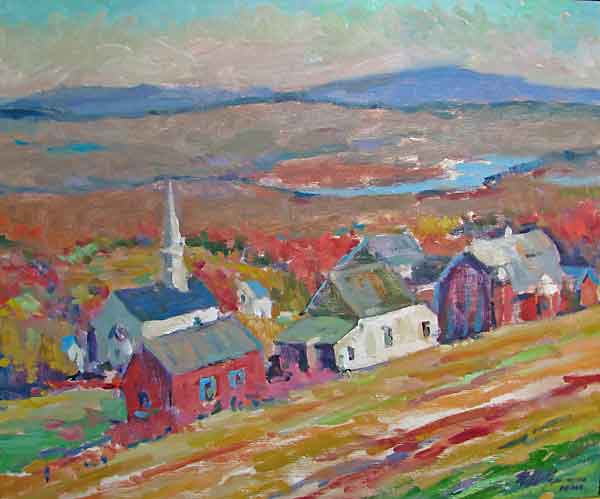
William St George
Countryside Village, Vermont, 1993
20 x 24 Oil on Canvas
$1400
Contemporary American Works in the Barbizon Manner
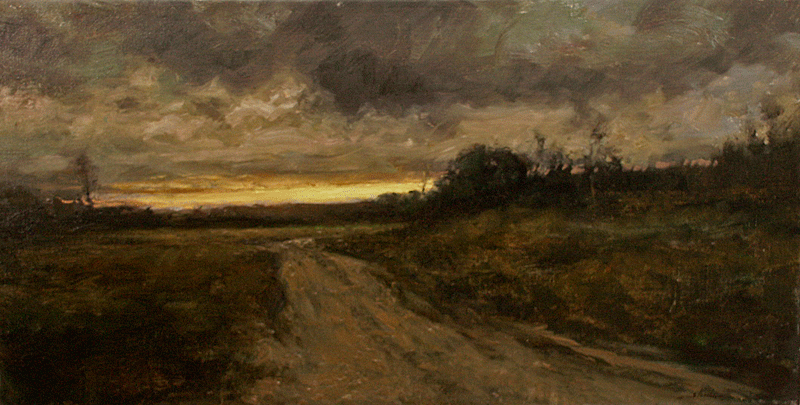
Approaching Storm
Oil on linen, 11" x 21"
Dennis Sheehan
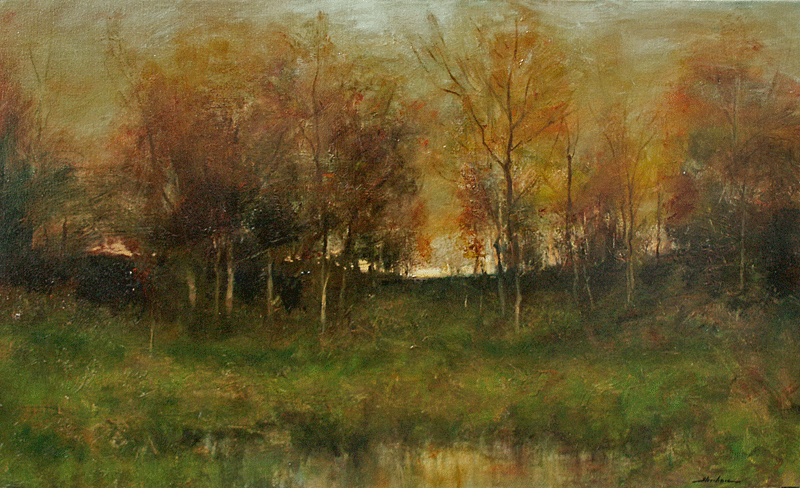
Autumn Glory
Oil on linen, 20" x 31"
Dennis Sheehan
Dennis Sheehan, born in Boston in 1950, is a member of the Guild of Boston Artists, and currently lives and works in the New Hampshire countryside. His work is in major public and private collections, including the White House. Sheehan paints in the Barbizon mode with remarkable authority and faithful adherence to his 19th century precursors. In the tradition of Inness and American Tonalist painters, Sheehan creates landscapes of mood, affected by nature's changing seasons. Mystery, dream, memory, and imagination are often espoused in their haunting, broadly painted canvases of dusk and moonlight.
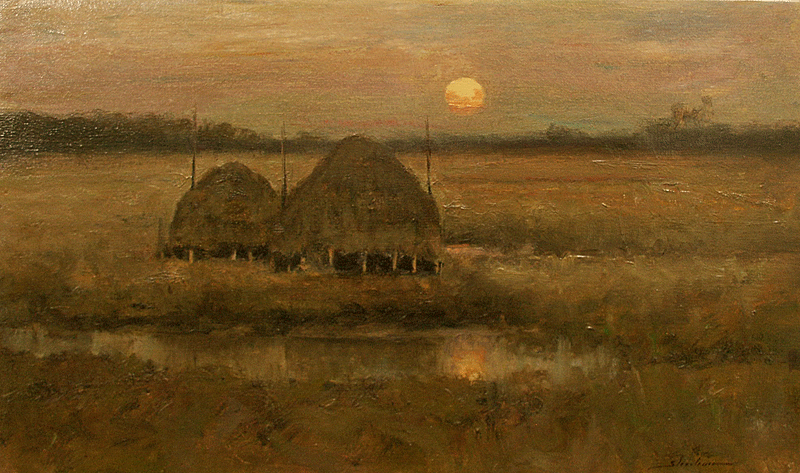
Hunter's Moon
(oil on canvas, 24" x 36")
Dennis Sheehan
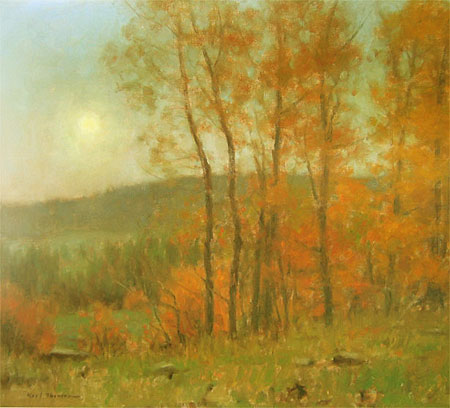
October Moon
(18x18 oil on canvas)
Karl Thomas
Widely acclaimed for his plein air compositions of the Grand Canyon of Arizona, The Grand Tetons of Wyoming and Wasatch Mountains near his Utah home, Karl Thomas acknowledges the influences of Inness, Sargent, Bierstadt and Moran on what he describes as his own style of "realistic impressionism." Early inspiration at his father's easel led to art studies at Brigham Young University, where he graduated in 1982, and the Los Angeles Art Center. Karl Thomas is represented by major galleries from California to New York. He was featured in the January/February 1990 issue of Art of the West and was selected in the top 100 artists in the Arts for the parks Exhibition in 1995.
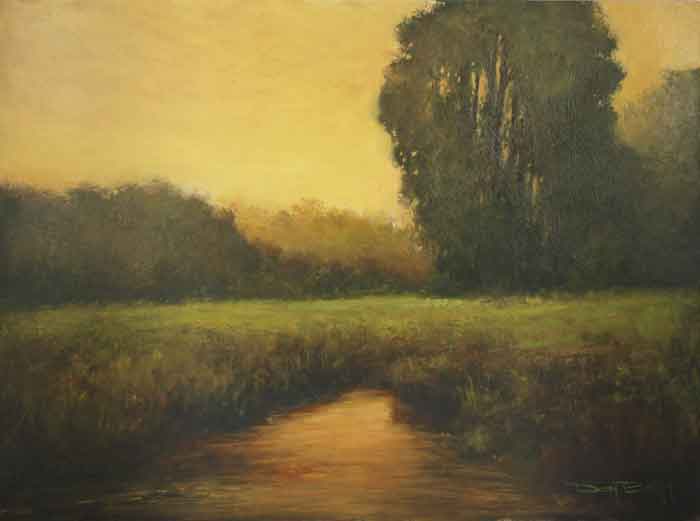
Quiet Meadow
(oil on canvas, 12"x16")
Don Bishop
Don Bishop is rapidly emerging as one of the most accomplished tonalist painters in the Pacific Northwest where he divides his time between plein air and studio work. Most of his pieces are painted alla prima using different color combinations according to the season and light. His roots are firmly planted in the early Californian impressionism because of the outstanding patterns of color and atmosphere associated with this school. Don has won several awards at recent shows including a blue ribbon at the 2003 Lake Oswego Art Festival, and has patrons throughout the US include Senator John Edwards and his wife, Elizabeth, of North Carolina.

Seaside Meadow
(oil on canvas, 16" x 20")
William McLane, Jr.
The works of William McLane, Jr. are highly collectible and hang in galleries and homes throughout the United States and abroad. His artwork is particularly well known on the East Coast – especially on the islands of Nantucket and Martha's Vineyard and the coast of Maine. He is a member of the Artist's Association of Nantucket. He is a versatile painter whose work varies from abstract to impressionism always with an effective vibrant use of color and excellent composition.
For prices of these and other works in this exhibition please see the "paintings and artists" section of the site. Better still, stop by and visit the gallery during next season.
See the calendar for future exhibitions.
|

|
|

